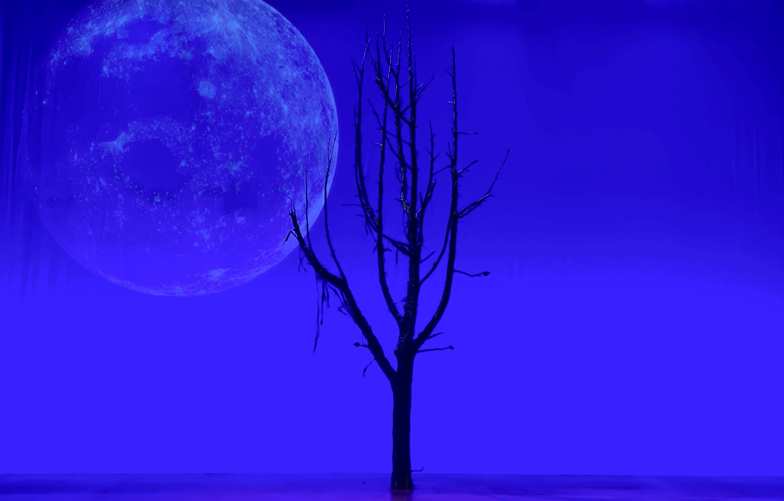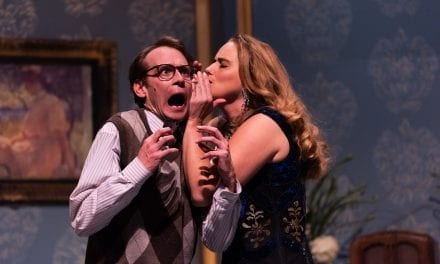SALT LAKE CITY — “Why people have to complicate a thing so simple I can’t make out,” says Samuel Beckett of his 1953 classic Waiting for Godot. Nonetheless, consumers of Godot have been ruminating the meaning of this play as well as Beckett’s intentions for nearly 70 years. Sting and Honey resurfaces this quandary in an encore performance ten years after their original run. A bewildering delight, this production shows audience members a display of existential crisis, a slapstick comedy, an allegory of war, a Christian dilemma, or any other number of countless interpretations Godot has received. Or, rather, using the guidance of director Javen Tanner, “there’s no key to understanding the play other than your own lived experience.” Dive down your own introspective rabbit hole. I hope you like what you find.

Show closes September 25, 2021.
Waiting for Godot follows two men for two days, or what may be two days. You see, time is a befuddlement in Godot. Vladimir (Didi) and Estragon (Gogo) spend the entirety of the play serving the title purpose of merely Waiting for Godot. Although, the audience doesn’t know who Godot is and will question whether Didi and GoGo know either. The clowning Vaudeville pair also seem unclear on what exactly they want from Godot. But one thing remains constant: waiting. Didi and Gogo tire of waiting, and they contemplate suicide, have meaningful and meaningless discussions, and just simply “clown” around. They are met by master Pozzo and slave Lucky who complicate their purpose, but alas the new arrivals do aid in passing the time. A young boy delivers the message Godot will arrive tomorrow, the same message as yesterday, and the day next.
Themes of the passage of time, insignificance, deity, and meaning(lessness) are auspiciously dressed in slapstick comedy and crowned with the absurdity of the characters. Waiting for Godot is stripped down, simple, and intimate. The set is sparse but complimented well by Jaron Kent Hermansen’s lighting design, which glows in the morning and dims in the evening. The lighting presents a full moon as the characters reach the dreaded night, lighter hues with comedic scenes, and redder hues in scenes of growing intensity. Hermansen’s design successfully sets the tone without having the support of sound, set, or costume changes.

David D’Agostini as Vladimir (Didi).
Tanner not only directed the show but also played Estragon. Tanner as Estragon was light and funny where appropriate, as when clowning around the stage, exaggerating injury, and battling his shoes that would not come off. Tanner was also very deliberate in moments of deeper contemplation. The character of Estragon often repeats, builds upon, and reacts to what Didi delivers, and Tanner did so very well. Tanner as Estragon and David D’Agostini as Vladimir had fantastic chemistry on stage. The couple seemed as though they had truly been endlessly Waiting for Godot as their frustrations and the silliness that comes with boredom felt genuine.
D’Agostini as Vladimir was fittingly fidgety and agitated, adopting a clown-style gait with a true embodiment of the character. It’s a tall order for two lone actors to achieve the dynamic performance that Godot demands. Hitting the comedic timing, exhibiting hopelessness, and relying solely on each other without sound and ensemble requires a strong match. I was not disappointed. I particularly enjoyed Tanner and D’Agostini in the opening of the second act in their characters’ quarrel, the scene in which they comedically performed lying on the ground while sorting through the changes in Pozzo and Lucky. I also generally enjoyed their dialogue—dialogue that was funny but also expressed deeper purpose such as when Vladimir says, “this is becoming insignificant,” to which Estragon replies, “not enough.” Adding to the success of production, Tanner’s direction created a nicely paced and engaging dialogue that was also strategically laced with well-timed pauses when the two “clowns” had a heavy or important line. I appreciated getting the time to absorb the script where needed, as there are so many fantastic one-liners and short passages entangled throughout the comedic action.

Roger Dunbar as Pozzo and Cam Deaver as Lucky.
Roger Dunbar as Pozzo and Cam Deaver as Lucky both had captivating performances as well. I was especially impressed with Deaver as Lucky as he showed an unfaltering tire as the old slave. At times where the focal point moved away from the character of Lucky, Deaver as Lucky still swayed and groaned in the background. Also, Deaver as Lucky was fascinating delivering the infamous monologue that contains everything from torrents of nonsense, to comments on tennis and to statements about man and God. Deaver as Lucky delivered with the correct level of madness to satisfy such a hodgepodge of content. Additionally, Dunbar as Pozzo exhibited a commanding ringmaster and egotist in act one and judiciously transitioned to a confused and feeble man for his character’s appearance in act two.
In summary, a pair of fools in a perpetual groundhog’s day of Waiting for Godot are dripping with humor with pops of the occasional existential gut punch; and I loved it. Not only do my commendations go to the direction and cast and crew, but they also go to the company Sting and Honey for choosing to perform this play. Waiting for Godot is a gem that can mean so much or so little or something entirely different from person to person, and the thought-provoking open interpretation is an intriguing mental treat. And here is a nibble, “Was I sleeping, while the others suffered? Am I sleeping now? Tomorrow, when I wake, or think I do, what shall I say of today?”
While I can’t even attempt to anticipate what this play will mean for you as a viewer, I do know that you shouldn’t miss your chance to go see it.

These reviews are made possible by a grant from the Salt Lake County Zoo, Arts, and Parks program.





